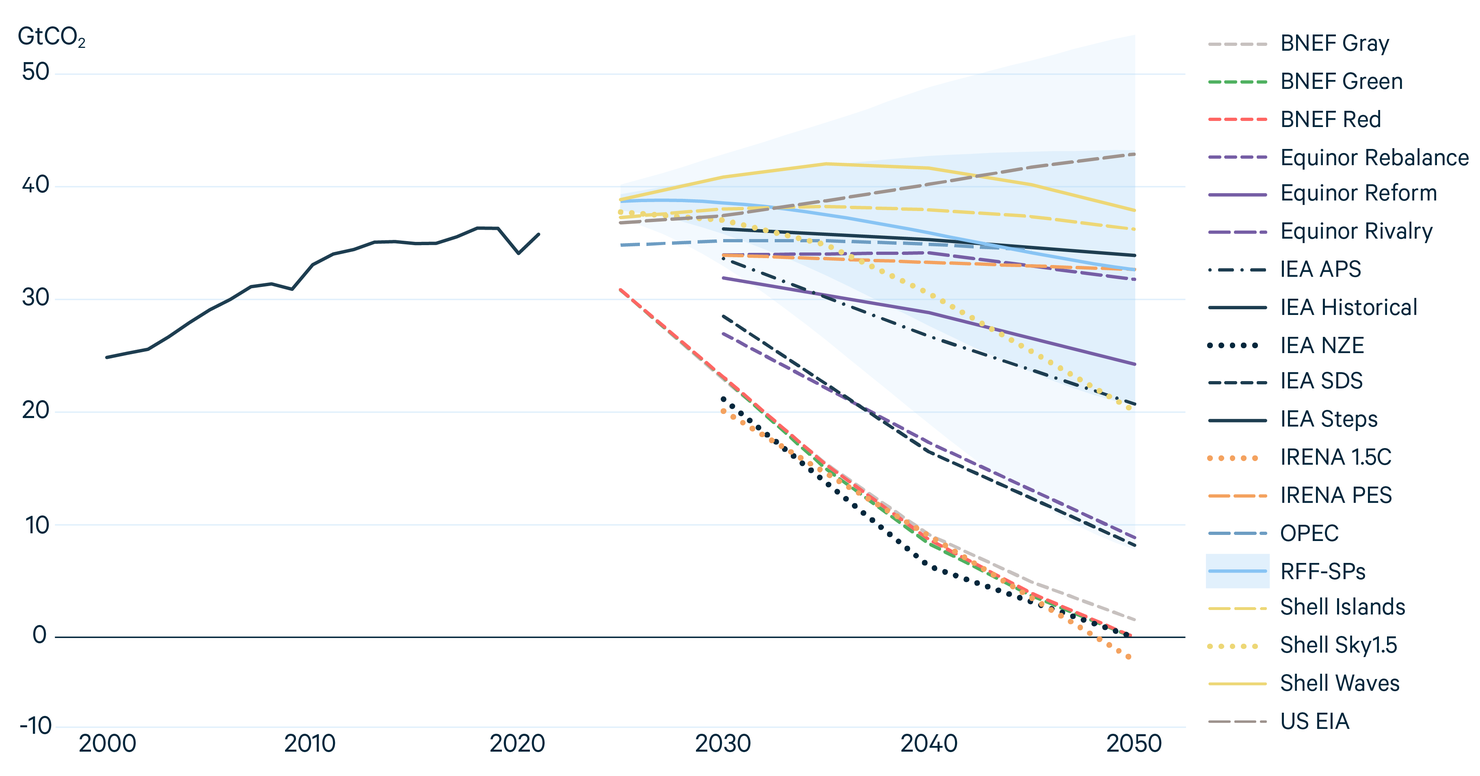As Energy Prices and Carbon Emissions Rebound, Uncertainty Pervades the Global Energy Future
Resources for the Future’s Global Energy Outlook 2022 shows our world at a crossroads—amid volatile energy prices and global tumult, 19 scenarios provide divergent potential futures for the energy mix and climate change.
Against a backdrop of geopolitical conflict, COVID-19, and ambitious international climate pledges, a new analysis from scholars at Resources for the Future (RFF) points to high levels of uncertainty in our global energy future—and the need for well-designed policy to enhance energy security and meet climate goals.
The Global Energy Outlook, an annual report released by RFF, provides a unique “apples-to-apples” comparison of energy projections by top institutions around the world. In their original forms, these outlooks depend on varying underlying assumptions and methodologies—the RFF report standardizes differing aspects to allow for a robust, harmonized analysis of the world’s potential energy futures. The report, which builds on projections released in 2021, gives insight into the wide range of energy projections and highlights the need for policy action.
“In tracking world energy demand and how it has been fueled over recent years, we see an increasing gap between ambition and progress,” said RFF President and CEO Richard G. Newell, who coauthored the study. “Some scenarios illustrate pathways to meet global climate goals; but the scenarios based on existing trends in evolving policies show that we are not currently on those pathways. Unless the energy transition speeds up, steeper future emissions reductions will be required to meet global decarbonization pledges.”
The authors categorized each future energy scenario primarily by the strength of its climate policies: reference scenarios assume limited or no new climate policies; evolving scenarios assume that announced policies will be implemented and that technologies will develop according to recent trends; and ambitious scenarios assume that policies will be enacted to limit global mean temperature rise to 2°C or 1.5°C.
The authors came to the following conclusions:
- In the near term, options for easing high energy prices are limited, but in the medium to longer term, energy security and climate goals can be enhanced by reducing fossil fuel use, increasing energy efficiency, and diversifying the supplies of fuels and inputs to clean energy technologies.
- Under all reference and evolving policy scenarios, global primary energy consumption grows considerably over the next three decades, but carbon emissions rise under only half of these scenarios, implying a less carbon-intensive energy mix and heightened energy efficiency.
- Under all scenarios, electricity generation from solar and wind grows dramatically and plays a central role in achieving long-term energy and climate goals in Ambitious scenarios. Under Ambitious scenarios, solar and wind energy grow at a spectacular rate; under some scenarios, annual additions of wind and solar are roughly equal to the cumulative level of wind and solar installed this century.
- Developing nations are expected to make up an increasingly large portion of global energy demand in the coming decades. Population and economic growth in African countries, for example, is expected to be substantial, and Africa’s share of global energy is expected to grow as well. Energy demand growth in China is expected to slow, and its coal use declines under most scenarios.
A key figure from the report shows that global carbon dioxide emissions projections exhibit a wide range of possible outcomes. Socioeconomic projections developed as part of RFF’s Social Cost of Carbon initiative place these scenarios in context, with the shading representing likely ranges of emissions projections.

“We are at a moment of exceptionally deep uncertainty,” coauthor and RFF Fellow Daniel Raimi said. “For example, the range of projected energy demand under these scenarios in 2050 for each major energy source—coal, oil, natural gas, nuclear, and renewables—is considerably wider than total consumption of each of those sources in 2021. Clean technologies are growing rapidly, but the key question is whether clean energy displaces, or simply adds to, our fossil fuel–based sources of energy.”
The report is accompanied by an update to the interactive Global Energy Outlook data tool and will be introduced at 12:00 p.m. ET on April 7 during the RFF Live event on the subject.
For more information, read Global Energy Outlook 2022: Turning Points and Tension in the Energy Transition by RFF Fellow Daniel Raimi, Research Analyst Erin Campbell, President and CEO Richard G. Newell, Fellow Brian Prest, Senior Research Analyst Seth Villanueva, and Research Associate Jordan Wingenroth.
Resources for the Future (RFF) is an independent, nonprofit research institution in Washington, DC. Its mission is to improve environmental, energy, and natural resource decisions through impartial economic research and policy engagement. RFF is committed to being the most widely trusted source of research insights and policy solutions leading to a healthy environment and a thriving economy.
Unless otherwise stated, the views expressed here are those of the individual authors and may differ from those of other RFF experts, its officers, or its directors. RFF does not take positions on specific legislative proposals.
For more information, please see our media resources page or contact Media Relations and Communications Specialist Annie McDarris.







